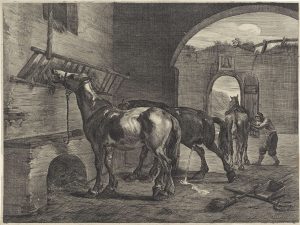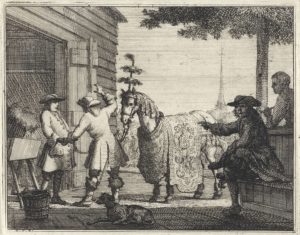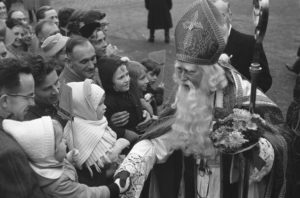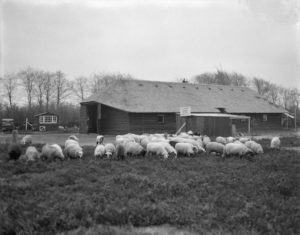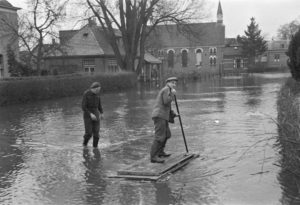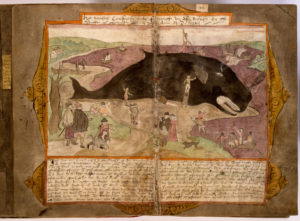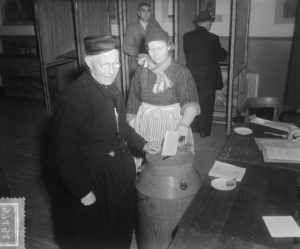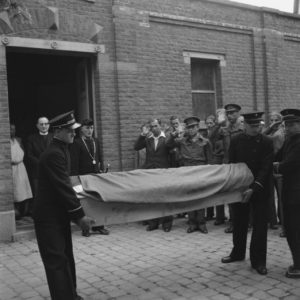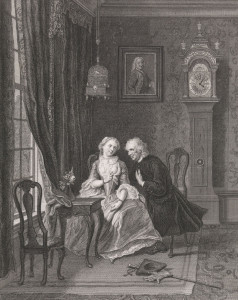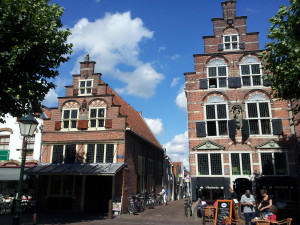A stal is a stable. A stalhouder is a stable keeper. Originally this would have been a cattle farmer, but the meaning later changed to somebody who rents out horses and carriages. … [Read more...]
Dutch term – Handelaar
A handelaar was a trader. Handelaren could mostly be found in cities, not villages, and were often quite well-to-do. Sometimes, specific words were used to show what people were trading in: a graanhandelaar traded in grain, a fietsenhandelaar traded in bicycles, and a handelaar in koloniale waren traded in colonial goods. You can also use newspapers, court records, or tax records to find out what your ancestor was trading in. Another word for handelaar is koopman (merchant), where … [Read more...]
Dutch term – Pakjesavond
Pakjesavond = "gift evening." Traditionally, Dutch families give gifts on St. Nicholas' Eve, on December 5th. Sinterklaas and his helpers, the Zwarte Pieten, will bring gifts for all the children and some of the adults too. "Santa Claus" is derived from the Dutch word "Sinterklaas." Read more about the differences and similarities about these red-robed men in the Sinterklaas article. … [Read more...]
Dutch term – Buurtschap
A buurtschap is literally a neighborship. It is a part of a municipality or parish. Unlike a village or town, a buurtschap usually does not have a center or church but consists of a group of farms dotting the landscape. Buurtschap is a word most commonly used in rural parts of the Netherlands. The closest English term would be hamlet. In many places, the buurtschap had an economical and a social function. Often, taxes were collected at the buurtschap level, and each buurtschap would … [Read more...]
Dutch term – Dijkgraaf
A dijkgraaf is a dike reeve, the head of a waterschap [water board]. He is responsible for the water management, including flood control, in his district. His function is similar to a mayor of a municipality. Nowadays, a dijkgraaf is appointed by the King for a period of six years. Historically, a dijkgraaf was usually somebody who had extensive property in the district for which he managed the water, to ensure he would do his best to keep the land dry. If your … [Read more...]
Dutch term – Walvisvaart
Walvisvaart is whaling. Dutch commercial whaling started in the 1600s. Many skippers from the province of Holland went north to the waters around Scandinavia and north of Russia to catch giant whales. The village of De Rijp had a thriving whaling industry and at one time had a fleet of ten whaling ships. The whale fat was turned into codfish oil, used for a wide range of purposes including lamp oil or as ingredient for soaps and paints. Whale bones were used to make glue or as building … [Read more...]
Dutch term – Verkiezing
Verkiezing means election. In the Netherlands, it took until 1917 for all men to get the vote. Before that time, only men with sufficient means were allowed to cast a vote. Women followed two years later and got the vote in 1919. In the Netherlands, citizens can vote for three levels of government: National (Tweede Kamer, house of representatives) Provincial (Provinciale Staten, provincial representatives) Municipal (Gemeenteraad, the town council) Water board … [Read more...]
Dutch term – Lijkkleed
A lijkkleed is a burial pall, the cloth used to cover the coffin. Many churches had a pall that could be rented. The rents were used to benefit the poor. In some cases, the account ledgers of the pall rents survived and can be used as death records. … [Read more...]
Dutch term – Huwelijkse voorwaarden
Huwelijkse voorwaarden (literally: marriage terms) is the Dutch term for prenuptial agreement. Historically, like today, most people did not have huwelijkse voorwaarden. Prenuptial agreements were often made by people who were well-to-do or who had children from a previous marriage to provide for. A prenuptial agreement identifies the spouses, sometimes accompanied by family members, and describes how the estate should be divided in case one of them dies. Usually, different scenarios are … [Read more...]
Dutch term – Heksenwaag
The Heksenwaag was the place where witches were weighed. Witches were known to be lighter than normal, in order to fly on a broom. People accused of witchcraft could go to a heksenwaag to be weighed and receive a certificate declaring them to be of normal weight, which they could then show to their accusers. … [Read more...]
